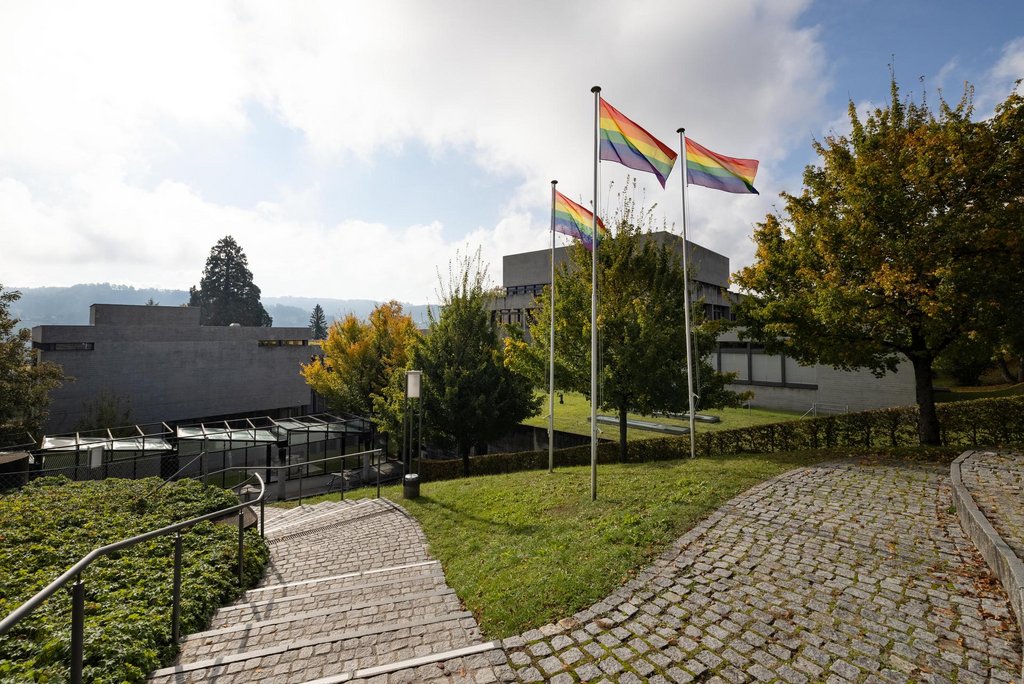Campus - 19.12.2023 - 14:00
HSG publishes its Diversity Monitoring Report 2023
In order to ensure equal opportunities, diversity and inclusion, the HSG has specific specialist units that work to further develop the University and ensure a comprehensive counselling service for students and staff. The 7th Diversity Monitoring Report (formerly Gender Monitoring Report) contains facts and figures as well as stories from members of the University.

Diversity in degree courses and appointments and a fair distribution of opportunities are key quality features of a university.
"As a leading business university, we set global standards in research and teaching by promoting integrative thinking, responsible behaviour and an entrepreneurial spirit of innovation in business and society." This approach has not only been a tradition at the University of St.Gallen since its foundation in 1898, but also a vision. To mark its 125th anniversary, the Diversity Monitoring Report contains historical milestones that continue to have an impact today.
Diversity in degree courses and appointments and a fair distribution of opportunities go hand in hand and are key quality features of a university. The topics of equal opportunities, diversity and inclusion have long been institutionally anchored at the University of St.Gallen and various service centres provide advice, information and sensitisation on these topics. This includes studies, work, academic careers, appointments to university management positions and the reconciliation of studies, work, family, and personal life. The use of inclusive language is also part of this.
Proportion of female students remains at 35
Overall, the proportion of women has stagnated at 35% across all divisions and study levels since the last two reporting years 2017 and 2019. Looking at one decimal place, there has been a slight increase from 34.6% (2017) to 35.0% (2019) to 35.4% in 2022. This slight increase is due to the increase at assessment level, where the proportion of women rose from 34% in 2017 and 2019 to 37% in 2022. At Bachelor's, Master's and doctorate level, the proportion of women remained unchanged compared to the previous year at 33%, 37% and 37% respectively. The gender ratio in the individual divisions continues to vary greatly. For example, the proportion of women at Bachelor's level varies between 23% in Economics and 59% in Legal Studies.
Major progress with the faculty (28%)
Thanks to a professionalised appointment procedure that specifically counteracts the biases that exist in the university system, the proportion of female professors has increased by five percentage points to 22% since 2019. If we take the professorship, associate professorship, permanent lecturer and assistant professorship levels together, the proportion of women has even increased by ten percentage points to 28% in the same period. If Lecturers are included, the proportion of women on the teaching staff is 33% (compared to 22% in 2019). It is pleasing to note that the gender equality target of 30% by 2025 for assistant professorships (44%) and associate professorships (39%) has been more than achieved by 2022. At 22%, there is still room for improvement for the level of professor ordinarius.
Highest proportion of women in administration at 60%
Administration is still the area of the university with the highest proportion of women. Across all administrative units and functional levels, it is 60% in 2022 (2019: 59%). The proportion of women varies greatly depending on the area. For example, it is only 14% in Real Estate, but 71% in the library. At management level, the proportion of women is virtually unchanged at 45% (2019: 46%) and at senior management level at 30%.
Women*@HSG, Pride Month, Leaders for Equality, Diversity & Inclusion Week and many more
In the report, students, staff and faculty members also provide an insight into the various initiatives on campus. For example, an information event for schoolgirls interested in studying was launched in 2021 on the initiative of the Diversity & Inclusion Office, the President's Board and the Branding and Marketing team. The "Women*@HSG" information day is intended to make it possible for young women to to get an insight into studying at HSG. The programme includes a panel with alumnae who talk about their study experiences and life after HSG. With the first "LGBTQ+ Pride Month", a student initiative, the University of St.Gallen took on a pioneering role in the Swiss higher education landscape in October 2020.
With the "Leaders for Equality" initiative, the Research Institute for Organizational Psychology (OPSY-HSG) has been supporting companies since 2020 in inspiring managers to promote equality in the workplace. This is because successfully dealing with diversity & inclusion is becoming a crucial core competence for organisations in times of generational change and a shortage of skilled workers. How Diversity & Inclusion can contribute to corporate success is demonstrated by researchers from various HSG institutes as part of the "St.Gallen Diversity & Inclusion Week", which has been organised annually since 2017 under the direction of the Competence Center for Diversity & Inclusion (CCDI-HSG).
About the report
The University of St.Gallen systematically collects and analyses data on gender distribution in the areas of degree courses, teaching, research & faculty and administration. Since 2020, the diversity dimensions of internationality, special needs and age have also been taken into account. The development of the figures over the years provides information on what has been achieved and in which areas there is still a need for action. Depending on the data available, the reporting period covers the academic years 2019/2020 to 2021/2022 or the calendar years 2020 to 2022.
The entire "Diversity Monitoring Report 2023" (in German) is available for download here.